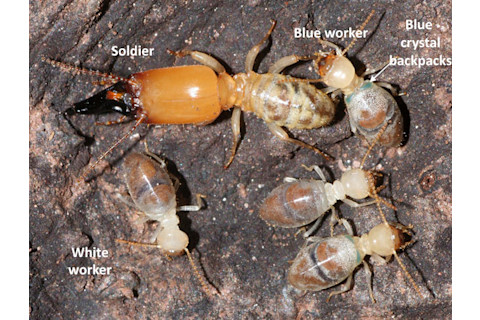
Termite workers don’t get to peacefully retire. As they age and their bodies can work no more, some of them are fitted with suicide backpacks and conscripted for war. There are thousands of termite species, and many engage in chemical warfare. Some squirt noxious chemicals from nozzles on their heads. Others violently rupture their own bodies to release sticky immobilising fluids, sacrificing themselves for the good of their sisters. Their range of weapons is astounding, and Jan Sobotnik from the Academy of Sciences of the Czech Republic and Thomas Bourguignon from the Université Libre de Bruxelles have just found a new one. They were studying the termite Neocapritermes taracua when he noticed that some workers have a pair of dark blue spots in the gap between their torsos and abdomens. When other termites attack their colony, the blue workers bite the intruders and burst, releasing a drop of fluid that soon becomes sticky gel. Watch it happen in the video below – the black dot in the middle of the droplet are intestines and other internal organs). [embed width="610"]http://youtu.be/XxgNR4pnvM8[/embed] The blue colour comes from crystals, secreted by a pair of glands at the base of the termites’ torsos. The fluid is deadly to other termites. When Sobotnik and Bourguignon dabbed the fluid on a competing termite species, 28 per cent were paralysed and 65 per cent died. If he removed the blue crystals, the fluids were far less lethal. Conversely, if he added the crystals to white workers, they became toxic (but not as toxic as the blue ones). The team think that the termites use a two-part weapon. The blue crystals are the first part. They contain a protein with copper atoms, which explains why they’re blue. The protein is a haemocyanin, which carries oxygen around the blood of insects just as haemoglobin does in our blood stream. The second part comes from the salivary glands, which, oddly enough, are found in the termite’s back rather than its head. Bourguignon thinks that when the termite bursts, the coppery protein transforms otherwise harmless compounds in the salivary glands, and turns them toxic. “The toxicity of the blue workers is clearly the result of mixing compounds from two sources,” he says. Sobotnik and Bourguignon found that this suicidal strategy is only used by older workers. Over time, their mandibles wear out and they can’t carry out the menial tasks that they performed in their youth. And as their mandibles become blunt, the blue crystals in their backs get larger. Compared to the younger white workers, the blue ones were more aggressive towards other termites, and exploded much earlier. Quoting E. O. Wilson, the duo writes, “We send our young men to war; ants send their old ladies.” The same could be said of termites. Reference: Sobotnik, Bourguignon, Hanus, Demianova, Pytelkova, Mares, Foltynova, Preisler, Cvacka, Krasulova & Roisin. 2012. Explosive Backpacks in Old Termite Workers. Science http://dx.doi.org/10.1126/science.1219129Image by R. Hanus More on insect defences:
Suicidal menopausal aphids save their colony by sticking themselves to predators
Suicidal menopausal aphids save their colony by sticking themselves to predators
Bees kill hornets with carbon dioxide emissions and local warming
Aphids hide from parasitic wasps among the corpses of their peers
Caterpillars use wormholes and early warning hairs for defence
Leaf beetle protects itself with a mobile home made of faeces













